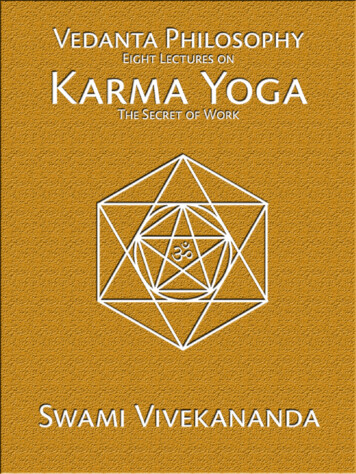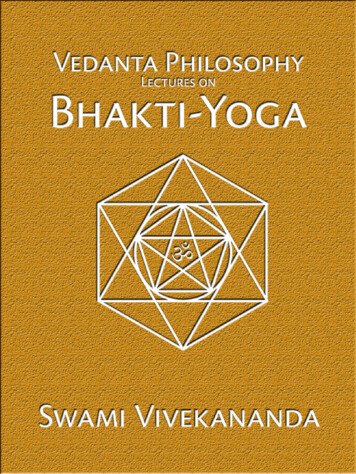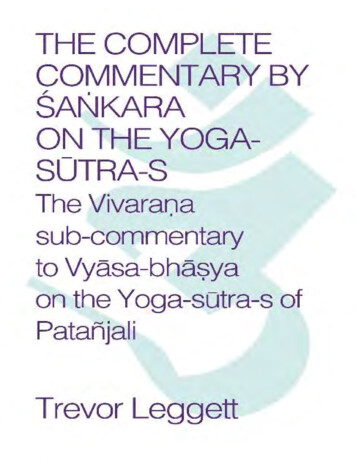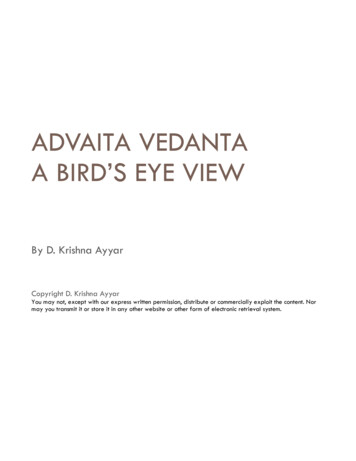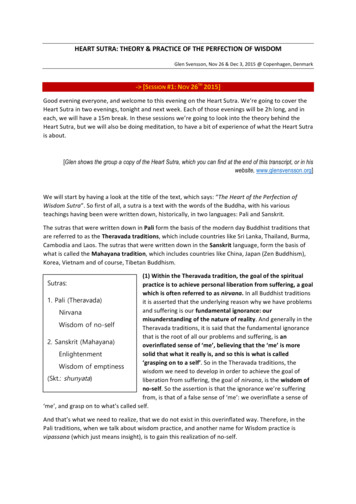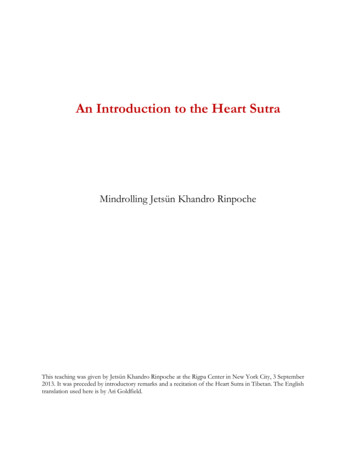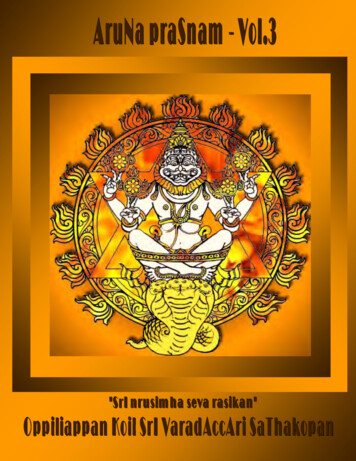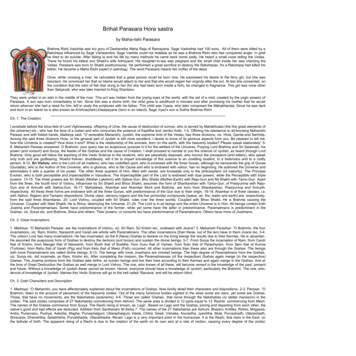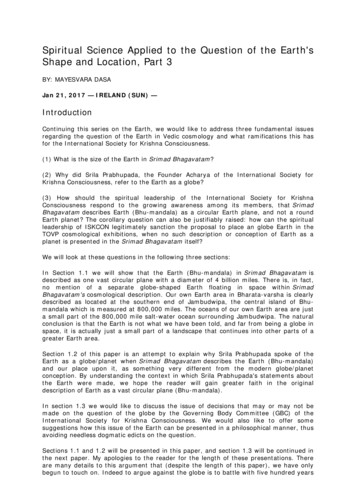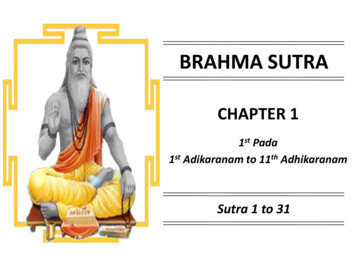
Transcription
BRAHMA SUTRACHAPTER 11st Pada1st Adikaranam to 11th AdhikaranamSutra 1 to 31
INDEXS. No.1TopicPagesSummary5Introduction of Brahma Sutra6Jijnasa adhikaranama)2Sutra 13Sutra 21034Sutra 31325Sutra 41223133Samanvay adhikaranama)12Sastrayonitv adhikaranama)Sutra No1Janmady adhikaranama)Topic No334204Ikshatyadyadhikaranam: (Sutras 5-11)445a)Sutra 532455b)Sutra 635356c)Sutra 735757d)Sutra 836258e)Sutra 936959f)Sutra 10372510g)Sutra 113765112
S. No.6TopicPagesAnandamayadhikaranam: (Sutras 12-19)Topic NoSutra No6a)Sutra 12382612b)Sutra 13394613c)Sutra 14397614d)Sutra 15407615e)Sutra 16411616f)Sutra 17414617g)Sutra 18416618h)Sutra 194256197Antaradhikaranam: (Sutras 20-21)7a)Sutra 20436720b)Sutra 214487218Akasadhikaranam :a)9Sutra 228460Pranadhikaranam :a)Sutra 2382294729233
S. No.10TopicPagesJyotischaranadhikaranam : (Sutras 24-27)Topic NoSutra No10a)Sutra 244861024b)Sutra 255081025c)Sutra 265131026d)Sutra 27517102711Pratardanadhikaranam: (Sutras 28-31)11a)Sutra 285261128b)Sutra 295381129c)Sutra 305461130d)Sutra 3155811314
SUMMARYBrahma Sutra BhasyamTopics - 191Chapter – 1Chapter – 2Chapter – 3Chapter – 4Samanvaya –reconciliation throughproper interpretationAvirodha – non –contradictionSadhana – spiritualpracticePhala – resultTopics - 39Topics - 47Topics - 67Topics 4174075
Lecture – 01Puja: Gratitude to lord for completion of Upanishad course (last Chandogya Upanishad BrihadaranyakaUpanishad). Brihadaranyaka Upanishad took 4 years to complete normally 6 Upanishad taken for study. Seek grace to complete Brahma Sutra in 3 yrs.Introduction: Written by Vyasacharya. 555 Sutras (Aphorisms). Small statement in capsule form. Aphorism deals with Vedantic teaching on Brahman. Heard, remembered, transmitted. How to store ideas in memory? 2 Ways :a)Keep ideas in sutra form, topics form, Sutras found in grammar, philosophy, ethics, sciencespurpose to remember.b)All ideas in metrical poetry form, verse form sing & remember Ramayana, Mahabharata, 18puranas. All ideas in 555 Sutras. Each Sutra atom bomb to expand.Vyasa’s 3 Projects / 3 Tasks- Extract right interpretationfrom 10 Upanishads.- Defend right teaching- Offensive refuting wronginterpretation.- Report logical loopholes inother systems.6
Who is qualified to study Brahma Sutras with advantage? One with strong logic, grammar, etymology. One who has studied 10 Upanishads. (Many Sutras from Chandogya Upanishad Brihadaranyaka Upanishad). One who does Parayanam of Upanishad – Remembers Mantras.Question: Do we need Brahma Sutra for Jnanam and Moksha.Answer: No – not required Gita Upanishads enough.Question: Why Brahma Sutra?Answer: It is one of 3 basic texts – Prasthana Trayam of Vedantic teaching.Prasthana Trayam basic text(To dwell in teaching)Gita- Smrithi Prasthanam.- Taught 10 times.10 Upanishads- Sruti Prasthanam.Brahma Sutras- Nyaya Prasthanam.- Taught once.- For teacher Sutra useful.7
Sutra: Code word – Can’t make any simple translation. Shankara Sutra Bashyam very famous 3 years to complete Mulam book - Buy from Motilal Banarsidas. RK Mission- Sutras with English translation.8
Lecture – 021) Superiority of Human:Common aspects with animals – Sadharmyam : Ahara – Eating Nidra – Sleep Bayam – Sense of insecurity Maithunam – Desire for propagation of Species.Vaidharmyam – Uncommon Aspects: Buddhi - Evolved intelligence.oRational thinking, Discrimination Right / Wrong, Real / Unreal, Good / Bad – Extra Faculty moredeveloped.oThinking faculty – Unique feature.oJudge / Reason / Achieve goal.oBecause of intellect, human forms opinion, have goal, work for achievement of goal.Human: Thinker with clear ideas.9
6 Topics Analyzed Come to Systematic Conclusion(2)(1)- Who is Jiva / living being?- What is Jagat?(6)- What are Sadhanas forMoksha - means by whichperson goes from bondageto liberation.(5)- What is Mukti, Mokshaliberation salvation? Not whimsical / casual thinker / capricious philosophy. Philosophy called Darshanam consistent view / teaching. Darshanika :(3)- Who is Ishvara – cause ofJiva & Jagat – “Source”(4)- What is Bandah?- Why suffering, humanbondage, misery, Samsara?One who holds philosophy. Because of his consistency, there will be followers. Founder – called Acharya – Darshanika.10
12 Philosophies6 Astikas1)2)6 NastikasAccept Veda Pramanam asreliable source of knowledge.Veda Astiiti Yaha Vadati SahaAstika.1)2)3)4)Don’t accept Veda Pramanam.Veda Nasti.Base on Pratyaksham,Perception and inference Anumanam reasoning.Veda Pramana Nasti Hi YahaVadati.1. Charvakas: Source: Brihaspati – Deva guru. To mislead Asura, he didn’t accept but to destroy Asuras. Asuras will follow materialistic philosophy. Will not accept Vedas. Prathama Sishya - Charvaka, popularized teaching.CharuVakaBeautifulSpeechEat, drink and be merry, for death is certain and thereis nothing beyond.11
Borrow and eat sweet things. Returning not my problem, take it you can. Will you go to hell after cheating? Kasmi Butasya Dehasya who knows after body turns to ashes Punar Agamanam Kutaha? Don’t believe in Sukshma / Karana Shariram all bluff who has seen. Don’t accept Punarjanmam, heaven, hell, Dharma . Accepts only sense pleasures as ultimate goal. Body is be all end all, no Atma. Modem science close to Charvaka. Consciousness is temporary product of matter. Don’t believe in scriptures Kevala Pratyaksha source of knowledge inference, not Jnanam, not Pramanam. Brihaspati – Founder. Prakrutam / wild / not considered in Brahma Sutra. Other 10 Philosophies, Analyzed, criticized in Brahma Sutra.2. Jainism: Formed by 24 Acharya Teerthakaras. 1st Acharya: Rishaba deva. 24th Acharyas : Vardhamana Mahavira also called Jinaha. Jayati iti Jinaha – one who has conquered his sense organs and minds passions – anger, etc.Jainism (One philosophy)ShvetanbaraDigambaraWhite robedSpace robed.12
3. Buddhism: Founder – Buddha – Prince Siddhartha enlightened one – Wise. No systematic philosophy. Uttered stray statements to disciples initially not well developed. King Ashoka follower – organized seminar – Develop : Tripatakam - 3 Books.TripatakamsSutra PitakamAbidharma PitakamVinaya PitakamPati: Sutta PitakamAbidamma Pitakam.Vinaya PitakamStatements of Buddha /MasterPhilosophyLifestyle4 Branches of BuddhismSountrantika- Based on Sutra bookVaibashika- Based on commentaryon Abidharma Pitakamcalled Vibhasha.Yogachara- Emphasis on Yoga Achara.Madhyantika- Golden middle.- Madhyantika Marga.- Follow disciplinesteaching.- Yukta Ahara, chestaha.13
Astika – Nastika: Sankhya, Nyaya, Veiseshikas. Accept Veda. Give primary importance to reasoning – hence called Tarquikas. Shankara calls all 4 6 as Nastikas.Vedas primary, logic secondary- Purva Mimamsa, Uttara Mimamsa.Logic primary, Vedas – secondary- Sankhya, Nyaya, Veisishihas, Yoga.- Tarqa supporting Vedas, good forunderstanding Vedic teaching.Common feature of all Darsanams: All presented in Sutra form by their founders.a)Sankhya Sutram.b)Yoga Sutram.c)Nyaya Sutram.d)Veiseshika Sutram.e)Purva Mimamsa Sutram.f)Uttara Mimamsa Sutram.14
12 Darsanams (Philosophies)Nastika (Don’t accept veda as pramanam)(1) Charuvaka(2) JainismShvetanbara(3) Sountrantika(7) Sankhya-Kapila muniDon’t accept IshvaraLogic primaryAccept vedasecondary.(8) Yoga- Patanjali- Accept vedasecondary- Logic primaryAstika (Accept veda as Pramanam)BuddhismDigambara(4) Vaibashika(5) Yogachara(9) Nyaya- Gautama- Logic primary- Don’t acceptIshvara vedasecondary(6) Madhyantika(11) Purva Mimamsa-JaiminiVeda primaryKarma Khanda basedLogic secondaryAccept Ishvara(12) Uttara Mimamsa-VyasacharyaVedapurva – supportingLogic secondaryJnana khanda basedAccept veda primaryAccept Ishvara(10) Veiseshika- Kaanada- Logic primary- Don’t acceptIshvara- Accept vedasecondary15
Uttara Mimamsa Sutrani – other names are Brahma Sutrani, deals with Brahma Vedanta Sutrani, SharirakaSutrani (Atma), Vyasa Sutram, Badarayana Sutram. Sarvagyatma – Condensed Bashyam of Brahma Sutra called Sankshepa Shariram. Because they are brief statements, there could be ambiguity / doubt regarding, Dvaitam, Advaitam.3 Popular Schools- Shariraka Mimamsa Bashyamor Nirvisesha Advaitamrevealed by Shankara.- Advaita Brahman withoutattributes.- Visishta Advaitam – “ShreeBashyam” by RamanujaAcharya. Our philosophy literature very vast. Ritualistic method of learning adopted. Dasa shanthi Mantras. Dakshinamurthy Namaskara.- Dvaitam Anubashya byMadhava Acharya.16
LECTURE 3 Dasa Shanti Mantras chanted together.1)Om, May Mitra be Propitious with Us, May Varuna be Propitious with Us, May the Honourable Aryama be Propitiouswith Us, May Indra and Brihaspati be Propitious with Us, May Vishnu with Long Strides be Propitious with Us,Salutations to Brahman, Salutations to Vayu (the Breath of Purusha), You Indeed are the Visible Brahman, I Proclaim,You Indeed are the Visible Brahman, I Speak about the Divine Truth, I Speak about the Absolute Truth, May ThatProtect Me, May That Protect the Preceptor, Protect Me, Protect the Preceptor, Om Peace, Peace, Peace.2)Om, May God Protect us Both (the Teacher and the Student), May God Nourish us Both, May we Work Together withEnergy and Vigour, May our Study be Enlightening and not give rise to Hostility, Om, Peace, Peace, Peace.17
3)May He, the Lord of all, pre-eminent among the Vedas and superior to the nectar contained in them, bless me withwisdom! May I be adorned with the knowledge of Brahman that leads to immortality! May my body become strongand vigorous (to practise meditation)! May my tongue always utter delightful words! May I hear much with my ears!Thou art the scabbard of Brahman hidden by worldly taints (not revealed by impure, puny intellects). May I neverforget all that I have learnt! Om peace, peace, peace!4)I am the destroyer of the tree (of samsar; worldly life). My reputation is as high as the top of the hill. I am in essenceas pure as the sun. I am the highest treasure. I am all-wise, immortal and indestructible. This is Trishanku’s realisation.Om peace, peace, peace!18
5)Om, That is Full, This also is Full, From Fullness comes that Fullness, Taking Fullness from Fullness, Fullness IndeedRemains. Om Peace, Peace, Peace.6)May my limbs, speech, Prana, eye, ear and power of all my senses grow vigorous! All is the pure Brahman of theUpanishads. May I never deny that Brahman! May that Brahman never desert me! Let that relationship endure. Letthe virtues recited in the Upanishads be rooted in me. May they repose in me! Om peace. peace. peace!19
7)Om, Let My Speech be Established in My Mind, Let My Mind be Established in My Speech, Let the Knowledge of theSelf-Manifest Atman Grow in Me, Let My Mind and Speech be the Support to Experience the Knowledge of the Vedas,Let what is Heard by Me (from the Vedas) be Not a mere Appearance but what is Gained by Studying Day and Nightbe Retained. I Speak about the Divine Truth, I Speak about the Absolute Truth, May That Protect Me, May ThatProtect the Preceptor, May that Protect Me, May that Protect the Preceptor, May that Protect the Preceptor, OmPeace, Peace, Peace.8)Salutations! May my mind and all these (the body, senses, breath etc.) be good and well! Om peace, peace. peace!20
9)Om, O worshipful ones, may our ears hear what is good and auspicious! May we see what is auspicious! May we singyour praise, live our allotted span of life in perfect health and strength! May Indra (who is) extolled in the scriptures,Pushan, the all-knowing Trakshya, who saves from all harm, and Brihaspati who protects our spiritual lustre,vouchsafe prosperity in our study of the scriptures and the practice of the truths contained therein! Om peace,peace, peace!10)He who creates this entire universe in the beginning, and He about whom the Vedas gloriously praise and sing, in HimI take refuge with the firm faith and belief that my intellect may shine with Self-knowledge. Om peace, peace, peace!21
11)Salutations to Brahman, to the holy sages that have given us the Brahma vidya; Salutations to thegreat Masters of Divine Knowledge and to all the masters that have awakened the Divine Wisdomin us. Om I am Brahman.Dakshinamurthy Stotram :(Salutations to Sri Dakshinamurthy Who Awakens the Glory of the Atman within us through His Profound Silence)The Entire World is Like a City Seen within a Mirror, the Seeing happening within One's Own Being, It is a Witnessinghappening within the Atman, (the Witnessing) of the Externally Projected World; Projected by the Power of Maya; Asif a Dream in Sleep, One Experiences this Directly (this Play of Maya) during Spiritual Awakening within the Non-DualExpanse of One's Own Atman, Salutations to Him, the Personification of Our Inner Guru Who Awakens ThisKnowledge through His Profound Silence; Salutation to Sri Dakshinamurthy. [Verse 1]22
Verse 2 :(Salutations to Sri Dakshinamurthy Who Awakens the Glory of the Atman within us through His Profound Silence)This World is Like a Sprout of a Seed Within which transforms what is Changeless state Before, appear Again as Spaceand Time, and endless Varieties of Pictures over it; all due to the Creation of Maya, This Unfolding of the World (fromthe Seed) which is Like a Play of a Magician, happens to one Who is Like a Mahayogi out of His Own Free Will (i.e. aMahayogi can enter the state of Samadhi out of his own free will and witness the unfolding of the world when Hecomes out of Samadhi), Salutations to Him, the Personification of Our Inner Guru Who Awakens This Knowledgethrough His Profound Silence; Salutation to Sri Dakshinamurthy. [Verse 2]Verse 3 :(Salutations to Sri Dakshinamurthy Who Awakens the Glory of the Atman within us through His Profound Silence)By This Throb Alone which is of the Nature of Eternal Underlying Awareness, the Unreal Forms get their Meaningsand Appear over the Mind, This Knowledge of the Atman Spoken of in the Vedas as "Tat-Tvam-Asi" is Imparted by OurInner Guru as a Direct Experience when we Surrender Whole-Heartedly to Him, By Direct Experience of thisKnowledge, the Delusion of being tossed within an unending Ocean of Worldly Existence will Not Appear Again,Salutations to Him, the Personification of Our Inner Guru Who Awakens This Knowledge through His Profound23Silence; Salutation to Sri Dakshinamurthy. [Verse 3]
Verse 4 :(Salutations to Sri Dakshinamurthy Who Awakens the Glory of the Atman within us through His Profound Silence)As the Light of a Great Lamp Situated Inside a Pitcher having Many Holes, Shine Outwards, similarly, the Knowledge ofThat Only (i.e. Atman) Throb Outwards through our Eyes and Other Sense Organs, "I Know", He Alone Shining (i.eAtman), This Entire World Shines Salutations to Him, the Personification of Our Inner Guru Who Awakens ThisKnowledge through His Profound Silence; Salutation to Sri Dakshinamurthy. [Verse 4]Verse 5 :(Salutations to Sri Dakshinamurthy Who Awakens the Glory of the Atman within us through His Profound Silence)Those who Consider the Body or Prana (Vital Force) or Sense Organs or the Changing Mind or the Void (Total NonExistence) as the "I", are Like a Naive Innocent Girl Child, or a Blind, or a Dull-Headed; they are Deluded but theyVehemently Assert their Points, The Inner Guru Destroys this Great Delusion Created by the Play of the Power ofMaya, Salutations to Him, the Personification of Our Inner Guru Who Awakens This Knowledge through His ProfoundSilence; Salutation to Sri Dakshinamurthy. [Verse 5]24
Mandukya Upanishad : Chapter IV IntroductionThis is the famous stanza in which we get the hierarchy of Acarya-s in the line of Sri Sankara and his disciples. We findthat the hierarchy starts with Lord Visnu from whom in the following sequence, the great knowledge has reached us –Sri Narayana, Vasistha, Sakti, his son Parasara, Vyasa, Suka, Gaudapada, Govindapada, Sri Sankara, Padmapada,Hastamalaka, Trotakacarya and Varttikakara i.e., Suresvara.Guru Stotram :Salutations to Master Shankara, Bhagavadpaada, the bestower of felicity and unity on humanity, and the repositoryof all the wisdom, contained in the sacred scriptures. He is the manifestation of compassion. [Mantra 22]Salutation to Shankara who has explained the mystic lore handed down to us by Baadaraayana (Vyasa). Let us adoreHim again and again – Aum Bhagavaan Shankara. [Mantra 23]25
Guru Stotram :I prostrate to Sri Dakshinamurti who manifests in three different forms as God, Guru and Self, and whose body is allpervading like the sky. [Mantra 24]Mangala Charanam :Let there not be any inauspiciousness. May Brahman, the Supreme Being, bless mankind with good children andgrant all auspiciousness (to us). [Mantra 6]That which has an extremely auspicious appearance, which is the eternal source of all auspiciousness, which grantsthe wishes (of all those) who meditate upon it, know that Brahman as all auspiciousness. [Mantra 7]26
Forever do I pay obeisance to my Preceptors who have expounded the entire Vedanta with the aid of Vyakarana(pada), Mimamsa (vakya) and Tarka (pramana) shastras.Mangala Charanam :In the beginning, it is said, that the two sounds OM and Atha (now) came from (the throat of) Brahman and thereforethey are auspicious. [Mantra 8] Traditional way.27
S. No.1.SourceTaittriya UpanishadSiksha valli :Prarthanaa)Mangalyamb) Hiranyagarba Namaskara- Auspiciousness- Prostration to embodiment of Devatas.- Prana Deva indiryasSanti Mantra :Om Sam no mitra samvarunah .Karma Deva indriyasc) Hiranyagarba Stuti- Glorification of Hiranyagarba as Prana /Vayu tatvam- Embodiment of Virtues Satyam, Ritam2.Taittriya UpanishadBrahmananda Valli :Santi Mantra :d) Guru – Sishya Rakshanam- Protection of Teacher – student.a) Guru Sishya Rakshanam- Protection of teacher – student foreffective communication.b) Veeryam Karvayahe- Not passive listening, active.- Both do homework for better grasping.Om Saha navavatu .c) Prayathna- Put effortd) Sowhardaha- Mutual goodwill- Teacher – has Compassion to student- Student – Trusts one Teacher- Good relationship lubricates smoothcommunication.28
S. No.3.4.SourceTaittriya UpanishadSiksha Valli :a) Medha Shakti- Memoryb) Jnanam- Knowledge of AtmaSanti Mantra :OmYaschandasamrsabhovisvarupah .c) Sharira yogyata- Sthula – Sukshma to be fit for Pursuitd) Continuous sravanam- Without Breake) Dharanam srutam megopaya- Retain whats learntTaittriya UpanishadSiksha Valli :a) Japa for Atma Jnanam –Quotes statement trishankurishi- Statement of Brahman Jnani afterreceiving teachinga) Ishvara Shakti- I am great as Ishvara. Omnipotent asLord. I have shakti of Ishvara.b) Glorious- Enliven, invigorate creation.- Have Ishvara Vibutib) Wealthiest- Have great wealth Brahman Jnanam.- In Due course student owns upstatement.a) Essence of UpanishadJivatma / ParamatmaAikyam- In terms of Atma Drishtyab) Karya – Karana Sambanda- With respect to Anatma. Creationc) Atma alone Satyam, Anatmais mithya- If you remove Atma, Anatma can’tsurvive independently.Santi Mantra :Om Aham vrksasyareriva .5.PrarthanaBrihadaranyakaUpanishad :Santi Mantra :Om purnamadahpurnamidam 29
S. No.Source6.Sama Veda Chandogyo Upanishad Keno Upanishad :Prarthanaa) Sharira Yogyata- Sraddha- Sthula – Sukshma Shariram (17 Organs)- Faith in Brahman until Studentunderstands Brahman.- Brahman not known through senseSanti Mantra :organs, not grasped handled byOm Apyayantumamanganivakpranascaksuh karmaindriyas, not thought by mind.- No Pramanam can reveal Brahman.- Not available for transaction.- Initial conclusion – Non-existent.- Naham Brahman Niracouryat- I say Brahman is there so that one day Iwill be able to understand that it is notsomething to be experienced.- It is myself the expeirencer. Till then letme have sraddha.b) Ishvara Anugraha- I shouldn’t reject Brahman- Ishvara should not reject me.c) Deivi sampat- Virtues required for Atma revelationd) Atmani Upanishadsu- Dharma Abayam, AmanitvamDharma Te mayi santuSadhana Chatushtaya Sampatti30
S. No.7.SourceRig Veda AitareyaUpanishad :Prarthanaa)AarjavamSanti Mantra :Om van me manasipratisthita .8.9.-Harmony of thought and wordUtter what I thinkThink what I utterNo split between thought and wordand deed.- Harmony of Kahika, Vachika, Manasapersonalityb) Grahanam- Grasp teaching- Vedas should search me.- Lord to Bring vedic knowledge to mec) Dharanam- Retentiond) Anusarana- Let my life be as per teaching,understanding of upanishade) Rakshanam- ProtectionSanti Mantra :Om bhadram no’pivatayamanah .2 Meaningsa) Addressed to Lord- Oh Lord lead our mind to Brahman,Badram, Auspiciousb) Addressed to Mind- Oh Mind, lead me to Brahman.Atharvana Veda :- Mundak Upanishad- Prasno Upanishad- Mandukya Upanishada) Badram, Svasti Mangalya- AuspiciousSanti Mantra :Om bhadram karnebhihsrunuyama devah .b) Sharira Yogyata31
S. No.10.SourceSvetasvataroUpanishad / KrishnaYajurveda :Santi Mantra :Om yo brahmanamvidadhati purvam yovai vedamsca .11.Prarthanaa) Saranagathi- I surrender to Ishvara. Its your job togive Virtues and guru.- Jnana Yoga – Precedes and ends withsharanagati.b) Stuti- Glorification – who creates Brahmaji- Hiranyagarbha Samashti – SukshmaSharira.- Ishvara Samashti Karana Sharira. Hiranyagarbha’s father- Giver of Vedas to Hiranyagarba,disciple of Ishvara.- By tapas, gathers by intuition.- Gurosthu Mounam vakyanamBrihadaranyakaUpanishad / VamshaBrahmanam :Santi Mantra :Om namobrahmadibhyobrahmavidya .- Guru Parampara worshipped- Brahmaji – Hiranyagarba – Vyasa –Shankara.- Incomparable gurus- In Association, I discovered BrahmeivaAham Asmi – I am Brahman.Sarva Upalava / DoshaRahitaha- Pure Conciousness, pragyana ghanahaShuddham- Such Ishvara who gave Jnanam toMaya Sahitam Brahma – Hiranyagarba Isurrender.32
S. No.11.SourceBrihadaranyakaUpanishad / VamshaBrahmanamPrarthanaName of Ishvara- Atma Buddhi Prakashaka revealer ofAtma JnanamGita :- Tesham Satata Yuktanam .- Why I want self knowledge because Iam mumukshu – seeker of Moksha.- Svarupa Jnanam not Vritti JnanamPratyag Arthaha Antar Atma- Inner reality- As such I am identical with BrahmanTo the ever – steadfast, worshipping Me with love, Igive the buddhi-yoga, by which they come to Me.[Chapter 10 – Verse 10]End : Chant 5 Dakshimamurthy slokas and Do Namaskara.Verse 6 :(Salutations to Sri Dakshinamurthy Who Awakens the Glory of the Atman within us through His Profound Silence)Just Like the Sun and the Moon are Eclipsed by Rahu, the Pure Consciousness is Eclipsed by Maya (for a spiritually ignorantperson), A Spiritually Elevated Soul can enter that state of Unborn Deep Sleep (i.e. Pure Consciousness) by Withdrawing HisSense Organs to such an extent that Only the Real Essence remains, That state (i.e. Pure Consciousness) is experienced duringSpiritual Awakening whereby one clearly Perceives that "Before I was Sleeping" (by being eclipsed by Maya), Salutations toHim, the Personification of Our Inner Guru Who Awakens This Knowledge through His Profound Silence; Salutation to SriDakshinamurthy. [Verse 6]33
Verse 7 :(Salutations to Sri Dakshinamurthy Who Awakens the Glory of the Atman within us through His Profound Silence)During Boyhood and Other stages of Life (Youth, Old age etc), during Waking and Other states (Dreaming, Deep Sleep,Turiya etc) and Similarly in All Conditions the Atman Always Shines as the "I" Within, Free from All Conditions but atthe same time Present in All Conditions, The Inner Guru Awakens this Knowledge of One's Own Atman to those whoSurrender to Him; this Knowledge which is represented by the Auspicious Cin-Mudra, Salutations to Him, thePersonification of Our Inner Guru Who Awakens This Knowledge through His Profound Silence; Salutation to SriDakshinamurthy. [Verse 7]Verse 8 :(Salutations to Sri Dakshinamurthy Who Awakens the Glory of the Atman within us through His Profound Silence)The Differentiations that we See in the World as Cause and Effect, as Possessor-Possession Relations, as the DiscipleTeacher, and Also as Father-Son Relations etc, are all Differentiations within the One Atman, In Dream or Wakingstate, He, the One Purusha is always present, and (as if) Maya Wanders over Him and gives rise to all theseDifferentiations, Salutations to Him, the Personification of Our Inner Guru Who Awakens This Knowledge through HisProfound Silence; Salutation to Sri Dakshinamurthy. [Verse 8]34
Verse 9 :(Salutations to Sri Dakshinamurthy Who Awakens the Glory of the Atman within us through His Profound Silence)Earth, Water, Fire, Air, Space, Sun, Moon and Jiva, are Verily His (i.e. Atman's) Eight Manifestations Shining within theMoving and the Non-Moving forms, Apart from Him (i.e. Atman) there Cannot Exist anything; The Yogis who Reflect(i.e. Meditate) within Discover Him as the Essence From Which Everything Originates, . Discover Him as ExistingBeyond Everything as the Eternal Essence, Salutations to Him, the Personification of Our Inner Guru Who AwakensThis Knowledge through His Profound Silence; Salutation to Sri Dakshinamurthy. [Verse 9]Verse 10 :(Salutations to Sri Dakshinamurthy Who Awakens the Glory of the Atman within us through His Profound Silence)Since the Divine Essence in All is Made Clear in this Hymn, Hence by Listening to It, Contemplating on its Meaning,Meditating on It, and Glorifying it, One becomes Endowed with the Greatness of the Knowledge of the Divine Essence( present in All ); Perhaps the Divine Essence by Itself . will Awaken within him after that Again, the EightfoldManifestations of Divine Powers (Siddhis) Unimpeded. [Verse 10]35
LECTURE 4Prayer Verses – Meaning :1) Narayanam padma Bujam / Yo Brahma Vei Vidati Purvam - Salutation to all gurus.This is the famous stanza in which we get the hierarchy of Acarya-s in the line of Sri Sankara and his disciples. We find that the hierarchystarts with Lord Visnu from whom in the following sequence, the great knowledge has reached us – Sri Narayana, Vasistha, Sakti, his sonParasara, Vyasa, Suka, Gaudapada, Govindapada, Sri Sankara, Padmapada, Hastamalaka, Trotakacarya and Varttikakara i.e., Suresvara.1st AcharyaNarayanaBagawan VishnuPadmabuvamBrahmajiPutra Disciple from Vishnu’sNavel lotus cameVasishtamGot Knowledge by MeditationShaktiParasaraVyasaShukhaShankaraGovinda PadaGauda PadaPadma PadaHastamalikaTotakaSureshvaracharyaWalked on LotusBrahman as clear asNellikaiMetreVartikara36
Totaka – wrote : Sruti Sara Samudaranam (170 Verses). End – Bu padar yasya nabhi – Dhyana Sloka of Vishnu Sahasranama.Sureshvaracharya : Vartikam – Critical commentary on Shankara Bashyam. Taittriya Bashyam Brihadaranyaka Upanishad Bashyam 12,000 Verses (Main Work). All teachers directly, indirectly have contributed, hence I worship. Shankaras glory – Aalayam, Abode temple of vedic wisdom. Shankara knew vedas by heart – Shabda and Artha Grahanam. Had wisdom of Smriti – (Manu others) Sruti, 18 Puranas, Itihasa. (Ramayana Mahabarata (1 Lakh verses)). Quotes Ramayana – Once.Mahabaratha Many times. Vishnu Sahasranama Bashyam from Vishnu Purana. Bagawatam not quoted by Shankara may be later addition? Alayam – Abode of wisdom. Karunalayam – Abode of Compassion. Otherwise will not share wisdom, my superiority will go. No patenting. Leads us to Bhagavat Padam. Leads us all to. Bhagavan – Lord not away, different from me but me. Lokasankaraha – Mangalam karoti Brahma Ananda / Atma Ananda Svarupa Anandatvam Mangalam. Through written work, taught all generations. Jagat Guru – Loka Sankaraha.37
Guru Stotram :Salutation to Shankara who has explained the mystic lore handed down to us by Baadaraayana (Vyasa). Let us adoreHim again and again – Aum Bhagavaan Shankara. [Mantra 23] Prostration to Shankara Vyasa both Bagavans avataras not Jivas. Shankara is Lord Shivas Avatara. Vyasa is Lord Vishnus Avatara. Did Tapas in Badari Vanam – Badara Tree (Elanda Pasham Forest). Vishnu gave out Brahma Sutra. Vyasa wrote Commentary. Shankara wrote Bashyam. In Vishnus Hridayam is Shiva.a) Sutra Bashau Kritau Vande – 2 meanings Vyasa Author of Brahma SutraShankara – Commentatorb) Kalyana Sundara Shastrigal : SutraVistara – expanded by ShankaraUpanishad BashyamSangrahaha – Condensed by VyasaVyasa puts in pocket / Shankara wrote truck loads of notes.38
Removes misconception that Vyasa is founder of Sutra like others.PhilosophyFounderKapilaSankhyaPatanjaliYoga MuniNyayaGautama MuniVeisishikasKanaada Muni Didn’t exist beforeProduct of Human intellect, PaurusheyaTarqa Pradhana DarshanamWith Dosha Defect Uttara Mimamsa / Vedanta, not invention of Vyasa, but teaching extracted from vedas. Revealation by Lord, Apaurusheya. Vyasa – 6th Generation to reveal.Guru Stotram :I prostrate to Sri Dakshinamurti who manifests in three different forms as God, Guru and Self, and whose body is allpervading like the sky. [Mantra 24] When Lord is seen as Guru he is called Dakshinamurthy or Sadashiva – faces south.Narayana Padma VibhumSadashivaVishnuShiva / Dakshinamurthy39
South : Represents Yam Dharmaraja. Lord not afraid of Death. Mrtinjaya, Kala Kalaha.ChandraShekarMoonIn HeadRepresents Kala / Tithi Destroys Yama Bayam. Gives immortality by teaching Brahma vidya.Shiva appears in 3 formsIshvara- Prameyam- Subject Matter Guru- Pramanam- TeachingJiva / Sishya- Knower / Pramata in ClassAll one lord alone.Gita :And I am seated in the hearts of all ; from Me are memoryand knowledge, as well as their absence. I am verily thatwhich has to be known in all the Vedas ; I am indeed theauthor of the Vedanta, and the “knower of the Vedas”am I. [Chapter 15 – Verse 15]40
Vishnu / Shiva – Appear as 3 forms / expressions / murti.Original- Vyomavath space like Nirvikalpa(Undivided) Niravayava (Indivisible)- Mahakasha- Nirupadhika- All pervading real nature- Chaitanyam like AkashaNow- Ghatakasha- Auphadika Brahman most auspicious in the world – I prostrate. By remembering itself we get Mangalam. That Ishvara is Supreme Mangalam. Everything Auspicious because o
a) Keep ideas in sutra form, topics form, Sutras found in grammar, philosophy, ethics, sciences purpose to remember. b) All ideas in metrical poetry form, verse form sing & remember Ramayana, Mahabharata, 18 puranas. All ideas in 555 Sutras. Each Sutra atom bomb to expand. Vyasas3 Projects / 3 Tasks - Extract right interpretation from 10 .
